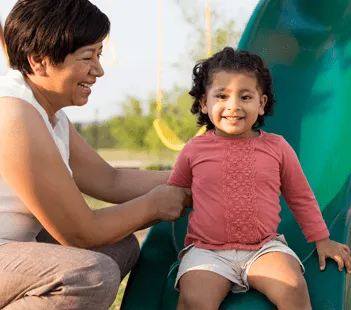January 01, 2017

Playgrounds can be wonderful places for families to exercise and play. They are also the source of hundreds of thousands of emergency visits to the emergency department for preschool and elementary aged children. (Between 2001 - 2008, an average of 218, 851 preschool and elementary children received emergency department care for injuries that occurred on playground equipment. Forty deaths were associated with playgrounds.) Fortunately, many of these injuries are preventable by following these safety tips.
- Provide adult supervision at all times.
- Wear shoes to protect feet.
- Make sure your child’s clothes are tucked in; items that may get caught in the equipment can be strangulation risk (hoodies, scarves, loose hanging strings, jewelry, hooks, cords, and helmets).
- Remove bicycle helmets prior to playing.
- Make sure playground equipment is age appropriate.
- Check the temperature of the equipment to make sure it is not too hot.
- Look for broken equipment, protrusions (such as S-hooks and bolts), sharp points or edges, and that equipment is anchored securely.
- Make sure the surface around playground equipment is made of wood chips, mulch, sand, pea gravel, or rubber mats; materials made with concrete, asphalt, grass, blacktop, packed dirt, or rocks are not safe for playground surfaces.
- Surfaces around playground equipment need to be 12 inches deep and extend at least 6 feet in all directions from play equipment.
- Check for spaces that could trap children, such as openings in guardrails or between ladder rungs; these spaces should measure less than 3.5 inches or more than 9 inches.
- Make sure platforms and ramps have guardrails to prevent falls.
- Remove tripping hazards, like exposed concrete footings, tree stumps, and rocks.
- Carry a basic first aid kit with you. Review and enforce playground rules.
- Play responsibly; no pushing or roughhousing.
- Take turns; one person at a time on a swing, slide, monkey bars.
- Remind children to sit down while swinging, slow down before getting off, and not walk close to someone swinging.
- Climbing up the front of a slide is not acceptable.
- Look before you jump or slide; make sure no one is below you.
Statistics
Playground Injury Locations
- 51% of the injuries happened on public playground equipment
- 19% occurred on home playground equipment
- 20% not recorded
- 1% Other
Playground Injury Causes
- 67% involved falls or equipment failure
- 8% hazards around but not related to the equipment
- 7% collisions with other children or the equipment
- 7% entrapments
- 11% other
Download Playground Safety Tips PDF
Reference: CPSC October 29, 2009

